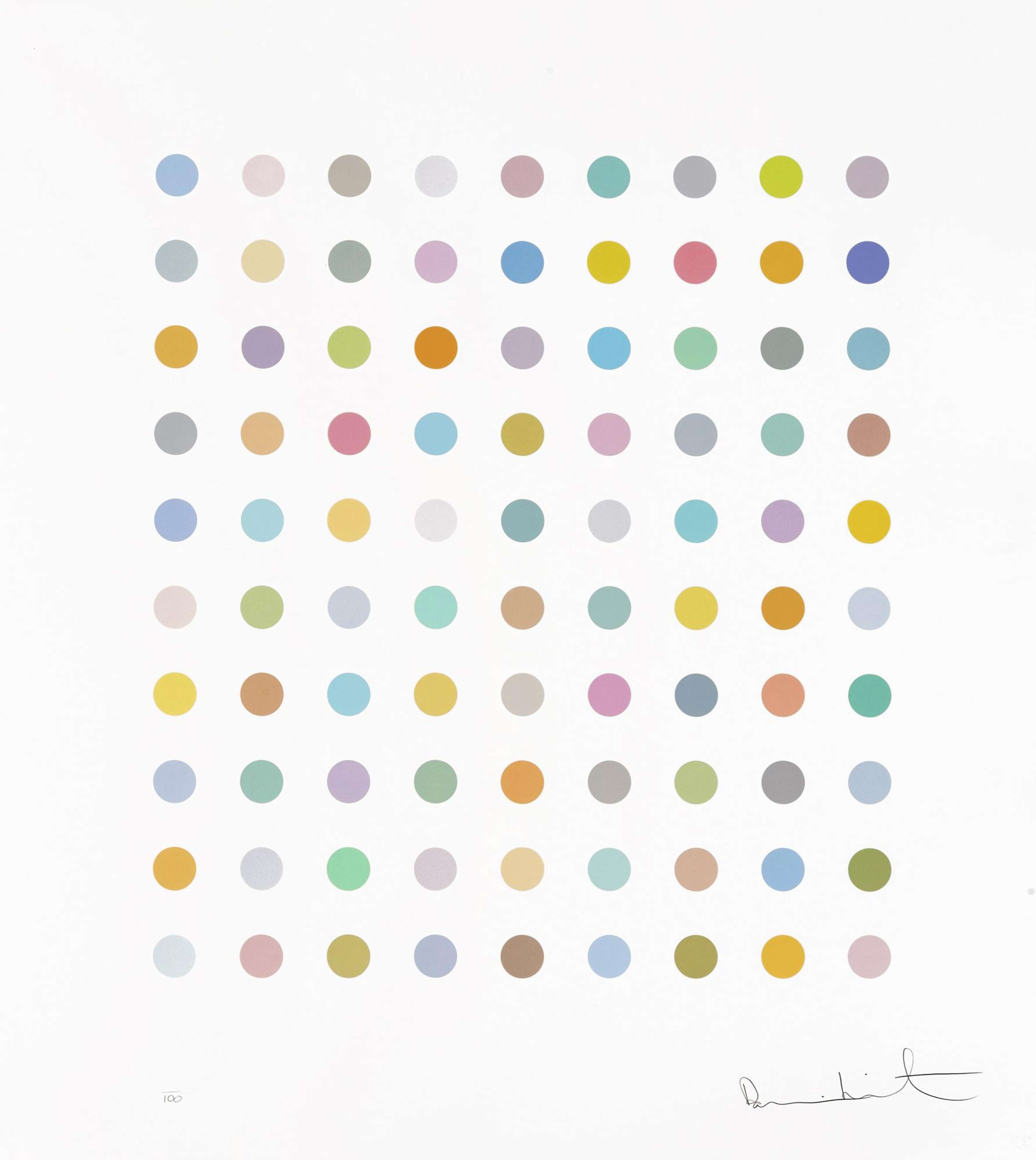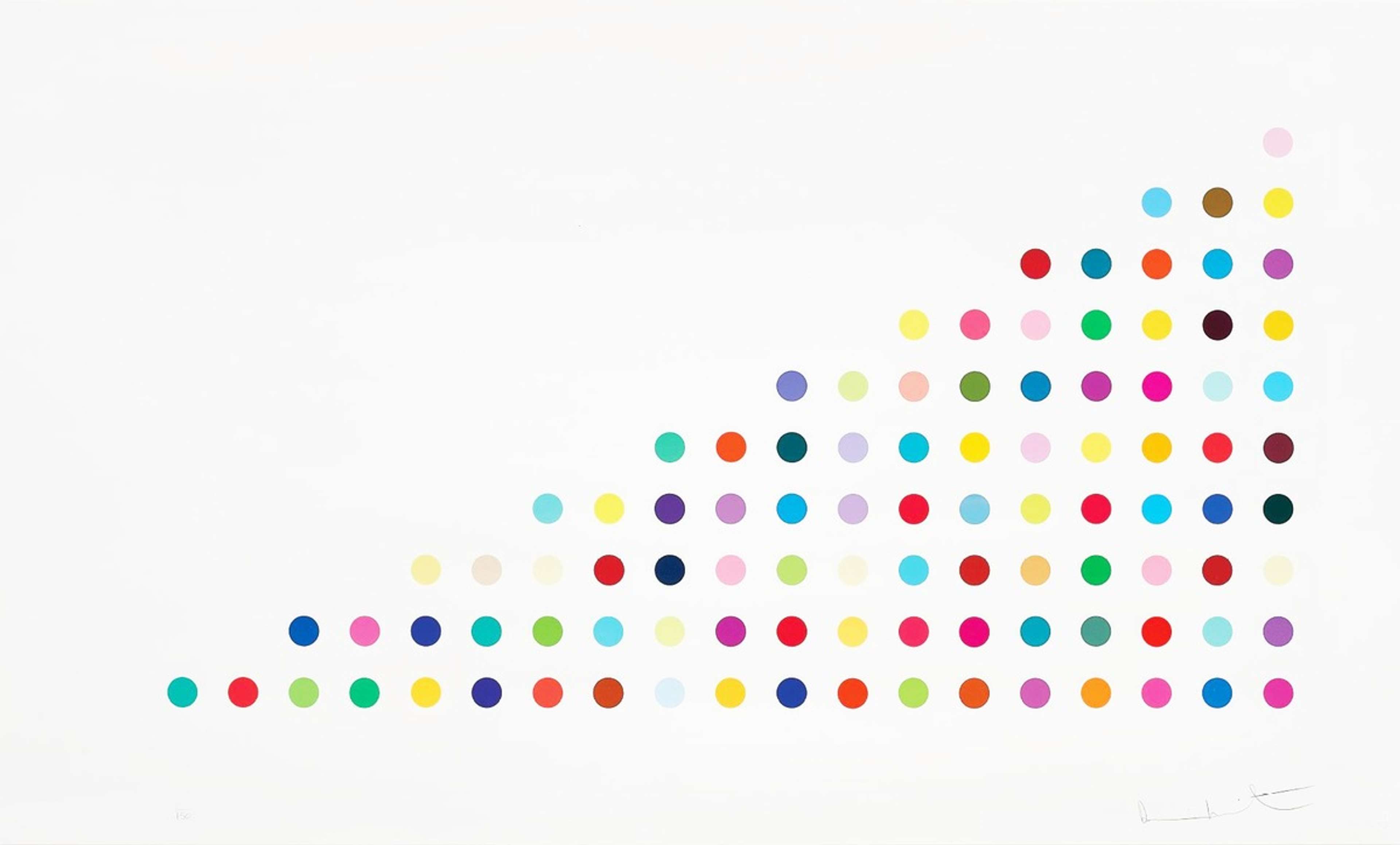 Vipera Lebetina © Damien Hirst, 2011
Vipera Lebetina © Damien Hirst, 2011
Damien Hirst
677 works
Universal, timeless and immediately recognisable, when you think of Damien Hirst, chances are his Spots prints are what spring to mind.
Damien Hirst’s Spots first appeared in 1986.
 Valium © Damien Hirst, 2000
Valium © Damien Hirst, 2000It was 2 years before his seminal group show, back in 1986, that Hirst painted some loose hand-painted Spots on board. This was followed by his first Spots work on canvas Untitled (with Black Dot) in 1988. At Frieze, Hirst painted two near-identical arrangements of coloured spots onto the wall of the warehouse. He called the works Edge and Row.
The Spot paintings are an endless exploration of colour and form.
 Methyamine © Damien Hirst, 2014
Methyamine © Damien Hirst, 2014The Spots paintings, on which this set of prints are based, form the basis for an endless exploration of colour and form. Indeed, Hirst has only occasionally halted production of his Spots paintings in his career, continually returning to them with a new variation, each associated with a specific drug group.
Hirst employs assistants to create his artworks.
 Tetrahydrocannabinol © Damien Hirst, 2004
Tetrahydrocannabinol © Damien Hirst, 2004Adding a factory-like approach to his practice, Hirst began to employ assistants to create his Spot works. This means that Hirst can produce a near-endless number of Spot prints.
This series explores the hand of the artist and mechanical reproduction.
 3-Methylthymidine © Damien Hirst, 2014
3-Methylthymidine © Damien Hirst, 2014Any physical evidence of human intervention, for instance the mark of a compass point left at the centre of each spot, was removed, until the works appeared to have been constructed mechanically, or “by a person trying to paint like a machine” as he put it.
No coloured dot is the same in every Spot painting.
 Aurous Iodide © Damien Hirst, 2009
Aurous Iodide © Damien Hirst, 2009Hirst has commented on the exploration of colour in his Spots paintings, explaining, “If you look closely at any one of these paintings, a strange thing happens: because of the lack of repeated colours there is no harmony. We are used to picking out chords of other colours to create meaning. This can’t happen. So in every painting there is a subliminal sense of unease: the colours project so much joy it’s hard to feel it, but it’s there.”
Each Spot print is named after pharmaceuticals.
 Vipera Lebetina © Damien Hirst, 2011
Vipera Lebetina © Damien Hirst, 2011Beyond the aesthetic qualities of the work, the name of each piece holds a crucial clue as to their possible meaning. The names are chemicals, which indicate each piece is a set of pills, a code or genetic structure that contains the bi-products of the stated name.
The name for each Spot print comes from a reference book.
 Opium © Damien Hirst, 2000
Opium © Damien Hirst, 2000In order to choose the names for his Spots paintings, each named after pharmaceuticals, Hirst bought the Physicians’ Desk Reference. This is a compilation of information on prescription drugs used by manufacturers, that is published commercially and updated every year.
The grid-like structure of each Spot print is important.
 Phendimetrazine © Damien Hirst, 2011
Phendimetrazine © Damien Hirst, 2011Each print uses the grid-formula to explore various colour combinations, each spot a different colour and each composition unique in its colour placements. Despite the way in which this print appears to be formulaic, the Spot prints retain a sense of expressiveness in their choice of colour that is informed by intuitive logic.
The Spot prints are Hirst’s most prolific artist output.
 Proctolin © Damien Hirst, 2008
Proctolin © Damien Hirst, 2008Hirst has produced over 1400 Spot paintings in total, with the help of his assistants, since their beginnings in 1988.
Hirst is supposedly working on a Spot painting comprising one million spots.
 Methyl Aspartic Acid © Damien Hirst, 2011
Methyl Aspartic Acid © Damien Hirst, 2011According to rumours in the art world, Hirst is reportedly working on a spot painting comprising one million spots. The work will apparently take around 9 years to complete.

